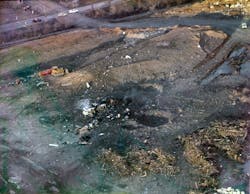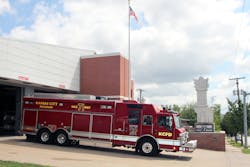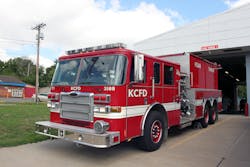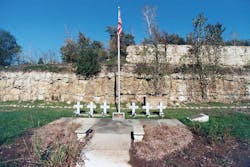About Kansas City, MO
The largest city in Missouri, Kansas City is located in the northwest corner of the state at the convergence of the Missouri and Kansas rivers. The city encompasses 319 square miles, with areas located in four counties. The Kansas City, MO, and Kansas City, KS, metropolitan area is estimated to include more than 2 million people.
KCFD early history
Kansas City’s early fire department was organized around 1858 with the formation of volunteer bucket brigades. Church bells would signal a fire alarm and everyone would assemble at the scene of the fire to help.
In 1868, the city abandoned the volunteer bucket brigade system and replaced it with a fully paid fire department. Initial firefighting equipment included a Silsby Rotary Engine with hose and two-wheeled hose wagons. Col. Frank Foster was elected as the first paid fire chief. Late in 1869, the first ladder company was organized, and named McGee Hook and Ladder #1, in honor of ex-Mayor E. Milton McGee. By 1872, the department consisted of three steamers, one hook and ladder, one chemical engine and 36 paid firefighters.
By the 1920s, the fire department had grown to 30 stations with 40 companies. In 1928, the first training school was opened, and the department was fully motorized. On March 14, 2018, Kansas City celebrated the fire department’s 150th anniversary.
Modern-day KCFD
The department operates from 34 fire stations with 1,200 uniformed personnel under the leadership of Chief Gary Reese, a 23-year veteran of the department who was sworn in as the 25th chief of the department on the day the department turned 150.
The department’s complement of apparatus includes 33 pumpers, 13 trucks, four quints, three rescue units, 54 medic units, one hazmat rig and two foam pumpers. The city is divided into seven battalions, and each battalion chief has their own driver. In 2017, the entire Kansas City Fire Department fleet was replaced with new Pierce apparatus.
Firefighters are trained to the EMT level and some are paramedics. KCFD responds to over 55,000 alarms each year with about 75 percent of those being emergency medical alarms.
The explosion
Pumper 41 arrived on scene at 3:46 a.m. and found two separate fires burning. A second pumper company was requested. Pumper 41 also requested that dispatch warn Pumper 30 of the potential for explosives at the site. Pumper 30 was dispatched and arrived on scene at 3:52 a.m. Because there were two separate fires at the site, the crew from Pumper 30 suspected arson and requested that the police be dispatched to the scene as well.
Approximately 5 minutes after the arrival of Pumper 30, Pumper 41 requested a battalion chief be sent “emergency” to the scene. There was a great deal of confusion at the site as to whether there were explosives on site or if the explosives were involved in the fires.
Following the extinguishment of the pickup truck fire, Pumper 41 proceeded to the other fire to assist Pumper 30. There was a truck, a trailer and a compressor on fire at 4:02 a.m. None of the vehicles or trailer appeared to be marked. There were no indications that the firefighters suspected any explosives were involved in the fires they were attempting to extinguish. As it turns out, the “trailer” that was on fire was actually an explosives magazine.
At 4:04 a.m., Pumper 41 contacted Battalion Chief 107, Marion Germann, who had been dispatched to the incident. They indicated that, “Apparently this thing’s already blowed up, chief. He’s got magnesium or something burning up here.”
At 4:08 a.m., 22 minutes after Pumper 41 arrived and approximately 16 minutes after Pumper 30 arrived, the magazine exploded, killing all six firefighters assigned to Pumper 41 and Pumper 30.
Germann and his driver were just arriving on scene and stopped about a quarter-mile from the explosion. They received minor injuries when the windshield of their vehicle was blown in. Following the first explosion, Germann ordered firefighters to withdraw from the area and a Command Post was set up at a safe distance from the site.
Approximately 40 minutes after the first explosion, a second blast occurred, followed be several smaller explosions. It is likely that Germann’s actions prevented additional deaths and injuries.
Both explosions left large craters where the trailer/magazines had been located. The first crater was approximately 80 feet in diameter and 8 feet deep; the second was approximately 100 feet in diameter and 8 feet deep. It was reported by the KCFD that the first explosion involved a split load of materials in the trailer/magazine. One compartment had approximately 3,500 pounds of ammonium nitrate/fuel oil mixture (ANFO). The rest of the contents were approximately 17,000 pounds of ANFO with 5 percent aluminum pellets. In the second trailer/magazine, there was approximately 1,000 30-pound “socks” of ANFO mixture with 5 percent aluminum pellets.
Pumper 30 was damaged beyond recognition. Pumper 41 received significant damage as well but could still be identified as a fire department vehicle.
Compounding factors and lessons learned
There were several circumstances that likely compounded the danger existing at the construction site. First, the dispatcher was told of the presence of explosives, but not what was stored, nor where or that the explosives were on fire. In retrospect, dispatchers should get as much information about an incident from the caller as they can. Dispatchers and 9-1-1 operators should have some basic hazmat training so they better understand what to ask of the caller(s). Both pumper companies were told of explosives on the site by the dispatcher, but nothing specific. This was a State of Missouri highway construction site with explosives in magazines and 50,000 pounds of ANFO mixture (most with aluminum pellets) stored in two trailers/magazines.
Additionally, the KCFD had not been involved in the blasting permit process and was unaware of explosives on the site prior to the incident, nor did the department have jurisdictional authority over the site. State highway sites are not under city control regarding permits or inspections, according to the city attorney. The Bureau of Alcohol, Tobacco, Firearms and Explosives (ATF) has universal jurisdiction over explosives except during transportation, but does not ordinarily inspect or issue permits for sites. Local fire departments are almost always the first responder, have their personnel at risk, yet do not always have regulatory control or guaranteed coordination from other agencies. Trailers/magazines probably were not placarded or marked to indicate contents. They were not required by ATF to be marked when parked on site.
DOT requirements for placarding and labeling at the time of the explosion only required them in transportation, not fixed sites. While there is no official ATF policy against placarding, there appeared to be a generally accepted practice in the field of removing placards when not in transit. As a direct result of the explosion and deaths of six firefighters, the Occupational Safety and Health Administration (OSHA) adopted regulations that require all transportation containers of hazardous materials continue to be placarded and labeled per DOT requirements when the containers are in fixed use and storage until the product is used up and containers have been purged of residual product.
The 1988 explosion resulted in the creation of a new position of deputy director within the KCFD for Health & Safety, which is currently held by Dr. Richard Gist. Gist has changed the culture of the fire department to be very proactive on issues of firefighter health and safety.
KCFD Hazmat team
The first hazmat vehicles included a 1989 E-One pumper (P71), a 1980s model Dr. Pepper roll-up delivery truck donated to the fire department (Support 71), and a 1997 GMC pickup truck with a Hackney body, Utility 71 (U71). The Dr. Pepper truck was later replaced by a 1993 Super Vac Hazmat Response Vehicle, the first hazmat vehicle built by Super Vac. In 2007, a motor vehicle accident (MVA) placed the Super Vac out of service and a reserve rescue unit was used.
Hazmat personnel received word in September 2006 that they would be getting a new response vehicle. The Super Vac rig was 13 years old and a total loss when it was involved in the 2007 MVA. Mark Cannon from KCFD contacted me about an article I wrote titled “Chicago’s Twins” (Firehouse Magazine, September 2005), which spotlighted the Chicago Fire Department’s twin hazmat units. Kansas City was interested in the design of the Chicago units.
After researching Chicago’s hazmat units and rigs from other departments in the Kansas City metropolitan area, hazmat team personnel drew up the specifications. The new unit was designed specifically to support local methods of operation. It took approximately one year from drawing board to delivery of the new vehicle in 2008.
Now identified as Hazmat 71 (HM71), the name of the new 2007 E-One was a combination of the number 30 and 41, as personnel from pumper companies 30 and 41 were lost during the 1988 explosion. The vehicle was originally located at Station 47.
Each month, the crews of Pumper 27 and Hazmat 71 swap roles to keep them familiar with each vehicle’s operations and give them needed experience.
All rescue companies in the city are trained to the Hazardous Materials Awareness & Operations level.
Station 27 was built in 1911 and housed a pumper until the late 1980s. A squad replaced the pumper until the early 1990s, when the station was closed. In the mid-1990s, the original Station 27 was torn down to make way for a new dedicated hazmat station. The new Station 27, located at 6600 Truman Road, houses Foam Pumper 71, a Pierce rig that is equipped with a 2,000-gpm pump, 1,000-gallon water tank, a 50-gallon foam tank and an additional 35 gallons carried in containers on top of HM71; Pumper 27, with a 750-gallon water tank, 1,250-gpm pump and a Foam Pro system with a 50-gallon foam tank; and U71. Pumper 27 responds to fire, EMS, MVAs and general non-emergency calls, in addition to hazmat runs. U71 is a secondary hazmat unit that carries supplies needed for extended hazmat incidents.
KCFD responds to approximately 1,900 hazmat calls per year, including fuel spills, odors, leaks, and carbon monoxide (CO) alarms. In 2006, they were the No. 1 hazmat team in the country in terms of total responses, according to the Firehouse Magazine National Run Survey.
Remembering the fallen
KCFD firefighters killed in the explosion:
· Captain Gerald C. Halloran, 57
· Thomas M. Fry, 41
· Luther E. Hurd, 31
· Captain James H. Kilventon Jr., 54
· Robert D. McKarnin, 42
· Michael R. Oldham, 32
For questions or additional information about the Kansas City Hazmat Team or this incident, contact Battalion Chief Pete Knudsen at [email protected] or (816) 513-4674.
About the Author
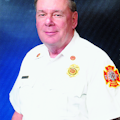
Robert Burke
Robert Burke, who is a hazardous materials and fire protection consultant and who served as a Firehouse contributing editor, is a Certified Fire Protection Specialist (CFSP), Fire Inspector II, Fire Inspector III, Fire Investigator and Hazardous Materials Specialist. He has served on state and county hazmat teams. Burke is the author of the textbooks "Hazardous Materials Chemistry for Emergency Responders," "Counter-Terrorism for Emergency Responders," "Fire Protection: Systems and Response," "Hazmat Teams Across America" and "Hazmatology: The Science of Hazardous Materials."
